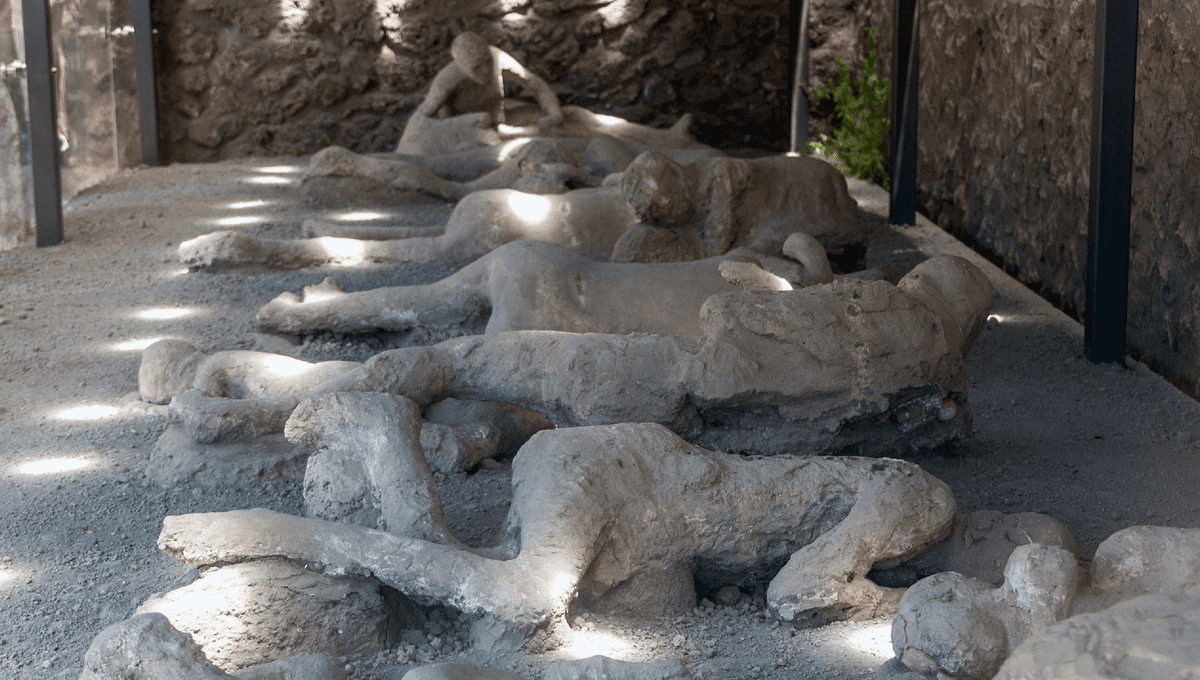
It was late October, in 79 CE, when the Apocalypse came to Pompeii. Mount Vesuvius, a major active volcano located just five miles from the flourishing resort town, finally made good on the threats it had been sending out for a decade and a half and erupted, flooding the nearby region with a deadly cloud of superheated gas, molten rock, and hot ash.
Today, things are a bit different. Pompeii is now a huge tourist attraction, drawing some 2.5 million visitors to the ancient town every year. Chief among the draws: the famous “stone” bodies of the poor souls caught too off guard to escape their grisly fate.
Except, here’s the thing: that’s not exactly what you’re looking at. While the image of hot molten rock overcoming the ancient townspeople, eventually cooling and turning its victims into timeless stone facsimiles of themselves, is no doubt evocative, it’s inaccurate – and in fact, if you had visited the site before the 1800s, those bodies would not have been there at all.
So what actually did create these iconic figures?
“The truth is […] they are not actually bodies at all,” explained Mary Beard, Professor of Classics at the University of Cambridge, in a 2012 article for BBC Magazine. “They are the product of a clever bit of archaeological ingenuity, going back to the 1860s.”
There had been sporadic excavations of Pompeii going all the way back to the late 16th century, but it wasn’t until this later period, under the direction of archaeologist Giuseppe Fiorelli, that the Pompeii we know today started to take shape. As these 19th-century excavators worked their way through the layers of debris and ash that covered the site, they started to notice something strange: a series of distinct holes and cavities, sometimes containing human remains.
What could they have been? In fact, these were the real “bodies” of the citizens of Pompeii – not the ashy models we’re used to seeing today, but the voids in the lava where, once upon a time, some poor victim’s shape held the lava open long enough for it to cool around their corpse.
“The material from the volcano had covered the bodies of the dead, setting hard and solid around them,” Beard wrote. “As the flesh, internal organs and clothing gradually decomposed, a void was left – which was an exact negative imprint of the shape of the corpse at the point of death.”
“It wasn’t long before one bright spark saw that if you poured plaster of Paris into that void, you got a plaster cast that was an exact replica of the body,” she added. “But [it’s] only a replica – more an ‘anti-body’ than a real body.”
Modern excavations have updated their methods slightly: “Nowadays we can better adopt X-ray techniques like 3D-CT scan to investigate the human content of plaster casts,” University of Naples anthropologist Pier Paolo Petrone told History and Archaeology Online in 2017.
But for the most part, new casts are made in a way that’s virtually identical to the first set all the way back in the 1860s, Petrone explained. While a clear epoxy resin may occasionally be used instead of plaster, the traditional mixture “remains the best to obtain perfect replicas of the victim’s bodies,” he said.
In summary, then: those ancient, petrified bodies of Pompeii? They’re not that. Neither ancient, nor petrified, they’re in fact modern plaster casts of the places where bodies once were. In fact, these days, they’re not even that exceptional: the technique used to make the figures can be reused, so that each body can be effectively “cloned” post-mortem as much as we like.
Which, by the way, is a good thing – or else we might not have as many of these “stone” people as we do. More than 160 bombs were dropped on the site in World War II, destroying much of the 20th century reconstruction that had taken place in the ancient city. “It was, frankly, a wreck,” wrote Beard. “Parts of what we now see are a rebuild of a rebuild.”
“I’m not accusing anyone of ‘faking it’,” she added. “My point is that our Pompeii – like most classical sites, in fact – is the product of collaboration between modern rebuilders and conservators, and the original Roman builders themselves, with the lion’s share of the work on our side.”
“And it’s no less impressive or moving for that – as the body casts help to show.”
Source Link: The Stone Bodies Of Pompeii Aren't What You Think